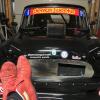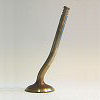Hi all,
I've been trying to get to the bottom of very hot engine temperatures which started occurring a few months ago.
I was getting readings of around 75-80% (i.e. halfway between Medium and Hot) on the standard Nippon gauge.
So I flushed the rad+heater, replaced the coolant, fitted a new 82deg thermostat, fitted a new 15lb rad cap, replaced the temp sender with a new one from a well-known supplier, but to no avail, the temp was still showing 75-80%. Coolant seems to be staying reasonably clean and blue after flushing.
So I suspected the voltage stabiliser (after all, I did have the gauges apart a couple of times last year and the workings of the fuel/temp gauge look very delicate indeed, so could easily have been damaged).
I isolated the built-in stabiliser and connected a new solid-state 10V stabiliser, but no success - the Nippon gauge was showing 80+% (with the new sender it seemed to be climbing even higher).
The new solid-state stabiliser was definitely working well, throwing out 10V according to the multimeter.
So getting cheesed off, I installed a TIM electric gauge supplied with matching sender.
But after just 15 minutes of driving, this gauge too is showing 100 degC !!
It has an 82deg thermostat so it really shouldn't be running much above 82.
Now you would think this just doubly confirms that there's an engine issue, but my infra-red meter shows considerably lower readings (see first photo):
 mini - infrared readings.jpg 74.43K
5 downloads
mini - infrared readings.jpg 74.43K
5 downloads
- half an inch above sender, 83 deg
- an inch above sender, 95 deg
- flat machined surface of cylinder head, 96 deg
- side of thermostat housing, 96 deg
- top of thermostat housing, 85 deg
- radiator header tank, 83 deg
- meanwhile, TIM gauge indicated temperature, 102 deg !!!
(I did these readings many times on several occasions and I get these results fairly consistently)
(Interesting, a few locations consistently show 83-85, which would be about right for my thermostat which is 82).
 TIM gauge reading.jpg 51.93K
10 downloads
TIM gauge reading.jpg 51.93K
10 downloads
My questions:
1. Which is likely to be more accurate, the infra-red readings or the TIM electric gauge?
2. What is the best place to take an infra-red reading? They vary so much by location! (I'm holding it 35cm away as per instructions)
3. Has anyone else had experience of a TIM gauge reading far too high?
4. What is the best way to figure out if my engine really is running so hot?
5. Leaving aside the possibility of gauge inaccuracy, at what engine temp should you pull over and stop driving? How hot is dangerous enough to start causing damage? 100deg? 105deg?
Also:
5. On the first photo, it can be seen that my fan is only 1/3rd of the way into the cowl, as shown by the clean sections on the tips of the blades. Most of the fan is outside the cowl. It currently has one 4mm spacer on it, as per factory standard. Do I need to add more spacers? How far in should it be?























